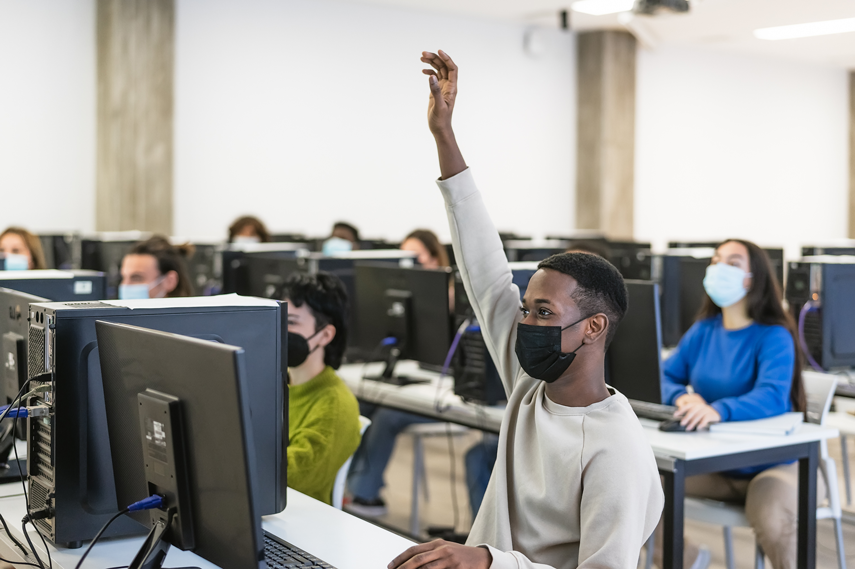
Academic normalcy in the U.S. still seems out of reach for many students, educators, and parents, even with the two-year mark of the initial wave of pandemic-induced school shutdowns fast approaching. Against the backdrop of the surge in COVID-19 cases towards the end of 2021, schools have been dealing with acute staff shortages, high absence and quarantine rates, and rolling school closures. And arisen as a result of this have concerns about lost instructional time.
By January 2022, the COVID-19 pandemic has already had a significant cumulative impact on student’s academic achievement; Changes in math and reading test scores have been monitored over the course of the first two years of the pandemic using data from 5.4 million U.S. students in grades 3 through 8, from the “immediately before the pandemic” fall 2019 to the “more than one year into the pandemic disruptions” fall 2021. Both math and reading test scores have been found to have significantly declined, with the math drops being significantly larger than projected impacts from other large-scale school disruptions, such as those following Hurricane Katrina. Even more concerning is that test-score gaps between students in low-poverty and high-poverty elementary schools have widened, primarily during the 2020-2021 school year; Further, achievement tended to drop more between fall 2020 and 2021 than between fall 2019 and 2020, shedding light on the fact that disruptions to learning have persisted to negatively impact students, even well past the initial blows following the spring 2020 school closures.
Despite being alarming and potentially demoralizing, especially in light of the heroic efforts of students to learn and educators to teach in incredibly trying times, in no way do these test-score drops suggest that these students represent a lost generation, nor that teachers are somehow at fault, yet nor that hope should be given up on; Rather, they highlight that “there’s a lot of work to do” for educators as new challenges have emerged — many beyond their control. Presented before school districts and states is a crucial decision as to which interventions to implement to counteract, if not reverse, the learning declines over the last two years.
The American Rescue Plan’s investments in the Elementary and Secondary School Emergency Relief (ESSER) gave public schools access to roughly $200 billion for COVID-19-related expenses. Of that amount, $22 billion is specifically allocated to address learning losses through evidence-based interventions, with a focus being placed on the disproportionate impact of COVID-19 on underrepresented student populations. According to an analysis of district and state spending plans, it has been revealed that districts are spending their ESSER funds intended for academic recovery on a wide variety of strategies, with summer learning, class size reduction, and high-dosage tutoring initiatives leading the pack.
To put the magnitude of COVID-19 impacts into context, the test-score drops during the pandemic are juxtaposed relative to the test-score gains associated with common interventions employed by districts as part of pandemic recovery efforts. This has been done to determine whether it can be assumed that if such interventions are to continue to be as successful in a COVID-19 school environment, these interventions will be sufficient and effective enough to help students catch up in learning, and reverse the learning losses.
The average effect of the summer learning in math is positive — though these programs alone are unlikely to reverse the test-score drops —, while that of the class size reduction is negative but not significant, with high variability in impact across different studies. Meanwhile, they both produce average effect sizes in the COVID-19 reading score drops, though the average effect of the tutoring on reading achievement is larger than those found for the other interventions. It is worth mentioning that despite that it yields the biggest effects, tutoring — which involves having full-time tutors supporting all students in one-on-one settings during the school day — can sometimes be quite time-consuming and likely costly.
However, there are some limitations, or even drawbacks, of drawing on research pieces conducted before the pandemic to understand how the COVID-19 test-score drops can be addressed. In particular, the conditions of these studies were vastly different than what each school is currently facing, raising a question as to whether the effectiveness of these interventions during the pandemic will be as consistent as it was before the pandemic, with a range of new challenges thrown in the mix that educators are facing in their efforts to close these gaps. Hence, the key to success is none other than timely feedback on the effects of the initiatives as well as necessary revisions, as it is doubtful that the existing initiatives will be executed uniformly and consistently across, and sometimes even within, districts.
All in all, students could catch up overall, yet the pandemic might still have lingering or even long-lasting, negative effects on educational equality in this country. Yet, there is still much work to be done. And, nevertheless, this might be the moment when decades of educational reform, intervention, and research begin to bear fruit. It is what we have learned now that could inform the path forward.
source:

